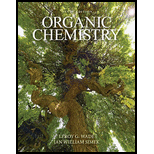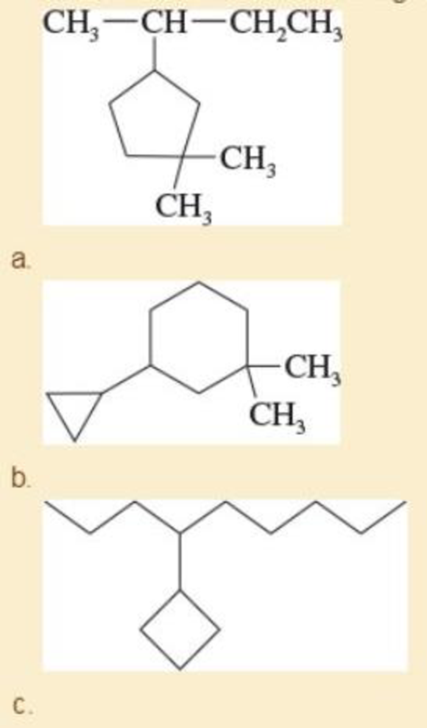
Organic Chemistry Plus Mastering Chemistry with Pearson eText -- Access Card Package (9th Edition) (New in Organic Chemistry)
9th Edition
ISBN: 9780321971128
Author: Leroy G. Wade, Jan W. Simek
Publisher: PEARSON
expand_more
expand_more
format_list_bulleted
Concept explainers
Textbook Question
Chapter 3.10C, Problem 3.15P
Give IUPAC names for the following compounds.

Expert Solution & Answer
Want to see the full answer?
Check out a sample textbook solution
Students have asked these similar questions
help
please help
please help
Chapter 3 Solutions
Organic Chemistry Plus Mastering Chemistry with Pearson eText -- Access Card Package (9th Edition) (New in Organic Chemistry)
Ch. 3.2 - Using the general molecular formula for alkanes:...Ch. 3.3B - Name the following alkanes and haloalkanes. When...Ch. 3.3B - Write structures for the following compounds. a....Ch. 3.3B - Provide IUPAC names for the following compounds....Ch. 3.3B - Prob. 3.5PCh. 3.3B - Prob. 3.6PCh. 3.3B - Prob. 3.7PCh. 3.3B - Draw the structures of the following compounds. a....Ch. 3.3B - Without looking at the structures, give molecular...Ch. 3.4C - Prob. 3.10P
Ch. 3.7B - Prob. 3.11PCh. 3.7C - Draw a graph similar to Figure 3-9, of the...Ch. 3.8B - Draw a graph similar to Figure 3-11, of the...Ch. 3.9 - Draw a perspective representation of the most...Ch. 3.10C - Give IUPAC names for the following compounds.Ch. 3.10C - Draw the structure and give the molecular formula...Ch. 3.11 - Which of the following cycloalkanes are capable of...Ch. 3.11 - Give IUPAC names for the following cycloalkanes.Ch. 3.12B - The heat of combustion of...Ch. 3.12C - Prob. 3.20PCh. 3.13B - The cyclohexane chair shown in Figure 3-22 has the...Ch. 3.13B - Draw 1,2,3,4,5,6-hexamethylcyclohexane with all...Ch. 3.14 - Prob. 3.23PCh. 3.14 - Prob. 3.24PCh. 3.14 - Draw the most stable conformation of a....Ch. 3.15 - Prob. 3.26PCh. 3.15 - a. Draw both chair conformations of cis-1...Ch. 3.15 - Prob. 3.28PCh. 3.15A - Draw the two chair conformations of each of the...Ch. 3.15B - Draw the most stable conformation of a....Ch. 3.16A - Name the following compounds.Ch. 3.16B - Prob. 3.32PCh. 3 - Prob. 3.33SPCh. 3 - Prob. 3.34SPCh. 3 - 3-35 a. Draw and name the five cycloalkane...Ch. 3 - Draw the structure that corresponds with each...Ch. 3 - Each of the following descriptions applies to more...Ch. 3 - Write structures for a homologous series of...Ch. 3 - Prob. 3.39SPCh. 3 - Construct a graph, similar to Figure 3-11, of the...Ch. 3 - The following names are all incorrect or...Ch. 3 - In each pair of compounds, which compound has the...Ch. 3 - There are eight different five-carbon alkyl...Ch. 3 - Use a Newman projection about the indicated bond...Ch. 3 - a. Draw the two chair conformations of...Ch. 3 - Draw the two chair conformations of each compound,...Ch. 3 - Using what you know about the conformational...Ch. 3 - Prob. 3.48SPCh. 3 - Draw Newman projections along the C3C4 bond to...Ch. 3 - Prob. 3.50SPCh. 3 - The most stable form of the common sugar glucose...Ch. 3 - This is a Newman projection of a substituted...
Knowledge Booster
Learn more about
Need a deep-dive on the concept behind this application? Look no further. Learn more about this topic, chemistry and related others by exploring similar questions and additional content below.Similar questions
- If 10 mL of a commercial sodium silicate solution is added, the water required to obtain a 20% solids solution (SiO2+Na2O) is added. Indicate the final grams of Na2SiO3.arrow_forwardPlease help me figure out the mechanism with arrows of the following reactionarrow_forwardOrganic Functional Groups Predicting the reactants or products of acetal hydrolysis termine the structures of the missing organic molecules in the following reaction: H* H* + H₂O Y ☑ Note: Molecules that share the same letter have the exact same structure. In the drawing area below, draw the skeletal ("line") structures of the missing organic molecules X, Y, and Z. You may draw that you like, so long as they aren't touching. Molecule X shows up in multiple steps, but you only have to draw its structure Explanation Check @2 W Click and drag to start drawing a structure. #4 # 3 LU E % 67 olo 5 66 R T Y & 7 AcGraw Hill LLC. All Rights R Xarrow_forward
- 8. (16 pts) Provide the stepwise mechanism for the synthesis of the following compound via an enaminearrow_forwardDraw the titration curve of (i) weak acid vs. strong base; (ii) weak acid vs. weakbase; (iii) diprotic acid with strong base (iii) triprotic acid with strong base.arrow_forwardComplete the reaction in the drawing area below by adding the major products to the right-hand side. If there won't be any products, because nothing will happen under these reaction conditions, check the box under the drawing area instead. Note: if the products contain one or more pairs of enantiomers, don't worry about drawing each enantiomer with dash and wedge bonds. Just draw one molecule to represent each pair of enantiomers, using line bonds at the chiral center. More... No reaction. my ㄖˋ + 1. Na O Me Click and drag to start drawing a structure. 2. H +arrow_forward
- Predict the intermediate 1 and final product 2 of this organic reaction: NaOMe H+ + 1 2 H H work up You can draw 1 and 2 in any arrangement you like. Note: if either 1 or 2 consists of a pair of enantiomers, just draw one structure using line bonds instead of 3D (dash and wedge) bonds at the chiral center. Click and drag to start drawing a structure. X $ dmarrow_forwardPredict the major products of this organic reaction: 1. NaH (20°C) 2. CH3Br ? Some notes: • Draw only the major product, or products. You can draw them in any arrangement you like. • Be sure to use wedge and dash bonds where necessary, for example to distinguish between major products that are enantiomers. • If there are no products, just check the box under the drawing area. No reaction. Click and drag to start drawing a structure. G Crarrow_forwardPredict the major products of this organic reaction: 1. LDA (-78°C) ? 2. Br Some notes: • Draw only the major product, or products. You can draw them in any arrangement you like. . • Be sure to use wedge and dash bonds where necessary, for example to distinguish between major products that are enantiomers. • If there are no products, just check the box under the drawing area. No reaction. Click and drag to start drawing a structure. Xarrow_forward
- Please draw the structuresarrow_forwardDraw the missing intermediates 1 and 2, plus the final product 3, of this synthesis: 0 1. Eto 1. Eto- 1 2 2. MeBr 2. EtBr H3O+ A 3 You can draw the three structures in any arrangement you like. Explanation Check Click and drag to start drawing a structure.arrow_forwardDraw the missing intermediate 1 and final product 2 of this synthesis: 1. MeO- H3O+ 1 2 2. PrBr Δ You can draw the two structures in any arrangement you like. Click and drag to start drawing a structure.arrow_forward
arrow_back_ios
SEE MORE QUESTIONS
arrow_forward_ios
Recommended textbooks for you

 General, Organic, and Biological ChemistryChemistryISBN:9781285853918Author:H. Stephen StokerPublisher:Cengage Learning
General, Organic, and Biological ChemistryChemistryISBN:9781285853918Author:H. Stephen StokerPublisher:Cengage Learning Organic And Biological ChemistryChemistryISBN:9781305081079Author:STOKER, H. Stephen (howard Stephen)Publisher:Cengage Learning,
Organic And Biological ChemistryChemistryISBN:9781305081079Author:STOKER, H. Stephen (howard Stephen)Publisher:Cengage Learning, Chemistry for Today: General, Organic, and Bioche...ChemistryISBN:9781305960060Author:Spencer L. Seager, Michael R. Slabaugh, Maren S. HansenPublisher:Cengage Learning
Chemistry for Today: General, Organic, and Bioche...ChemistryISBN:9781305960060Author:Spencer L. Seager, Michael R. Slabaugh, Maren S. HansenPublisher:Cengage Learning


General, Organic, and Biological Chemistry
Chemistry
ISBN:9781285853918
Author:H. Stephen Stoker
Publisher:Cengage Learning

Organic And Biological Chemistry
Chemistry
ISBN:9781305081079
Author:STOKER, H. Stephen (howard Stephen)
Publisher:Cengage Learning,

Chemistry for Today: General, Organic, and Bioche...
Chemistry
ISBN:9781305960060
Author:Spencer L. Seager, Michael R. Slabaugh, Maren S. Hansen
Publisher:Cengage Learning
Nomenclature: Crash Course Chemistry #44; Author: CrashCourse;https://www.youtube.com/watch?v=U7wavimfNFE;License: Standard YouTube License, CC-BY